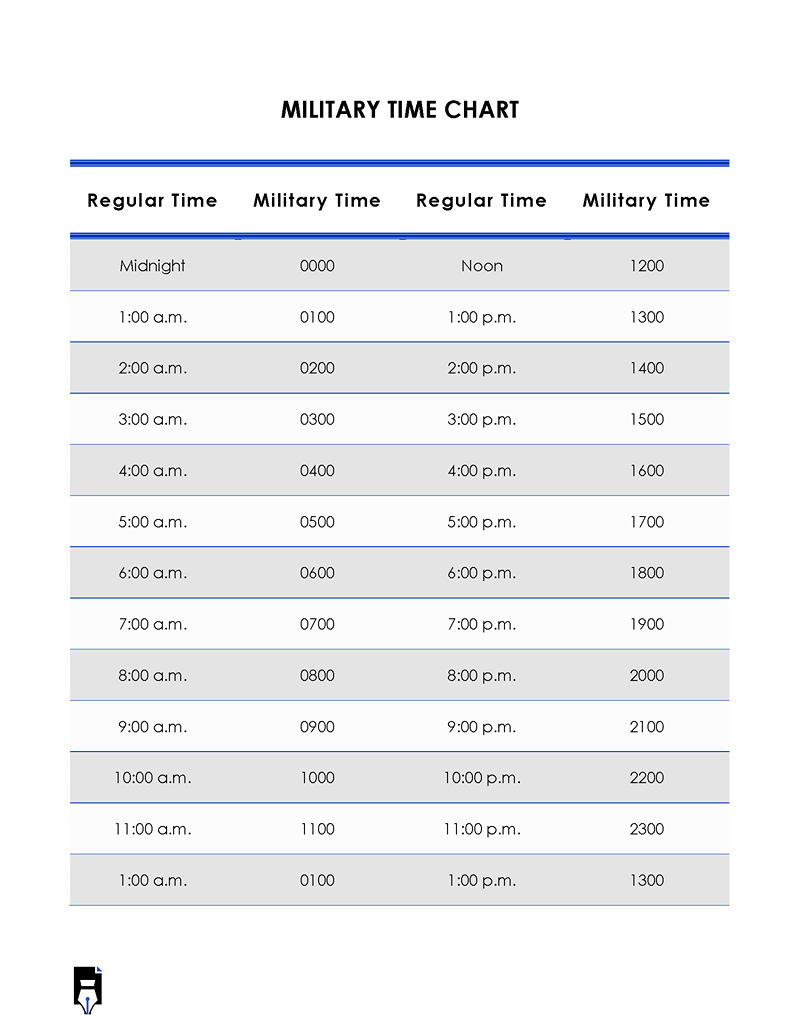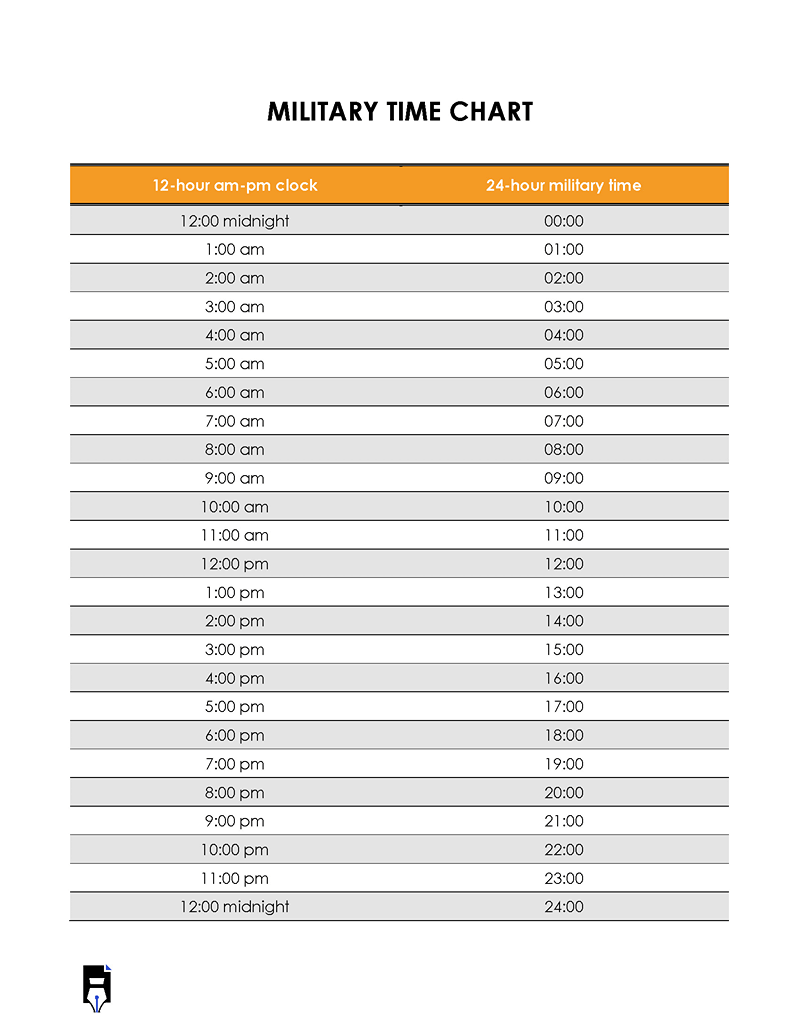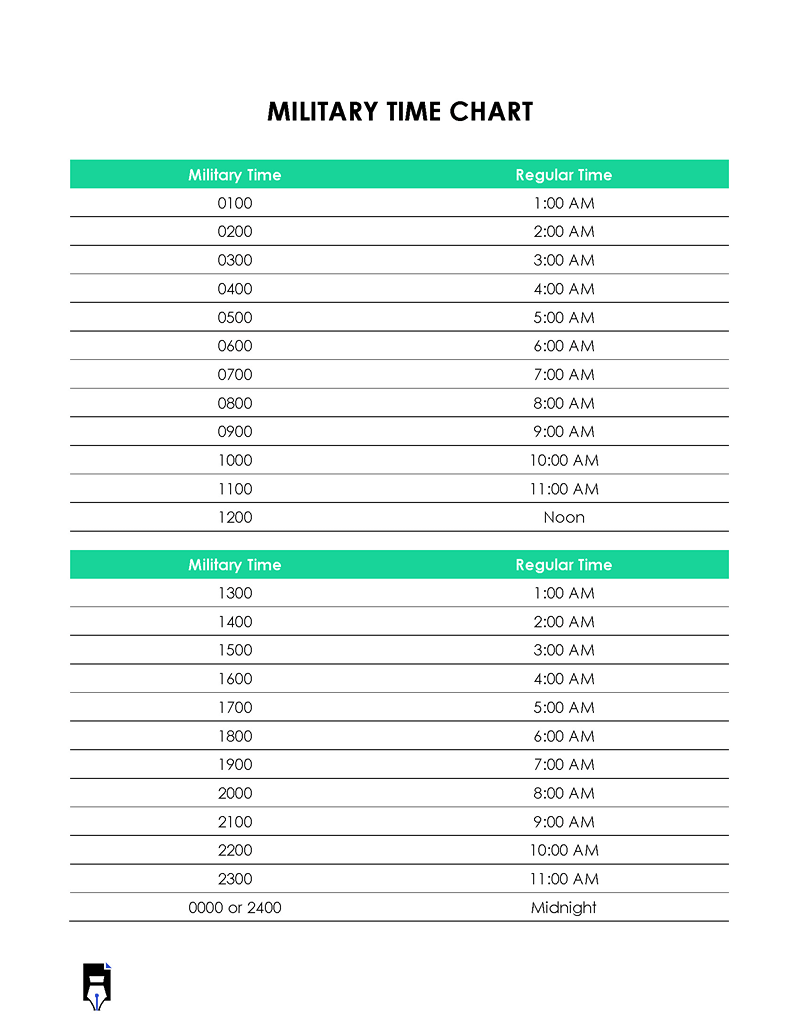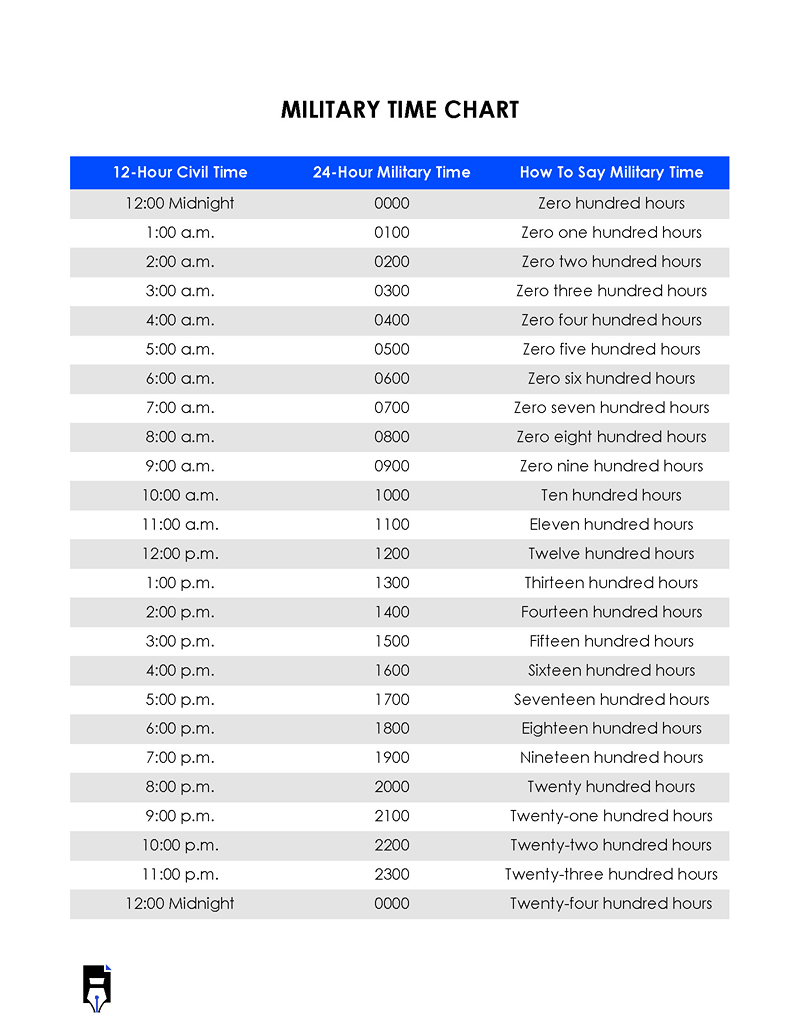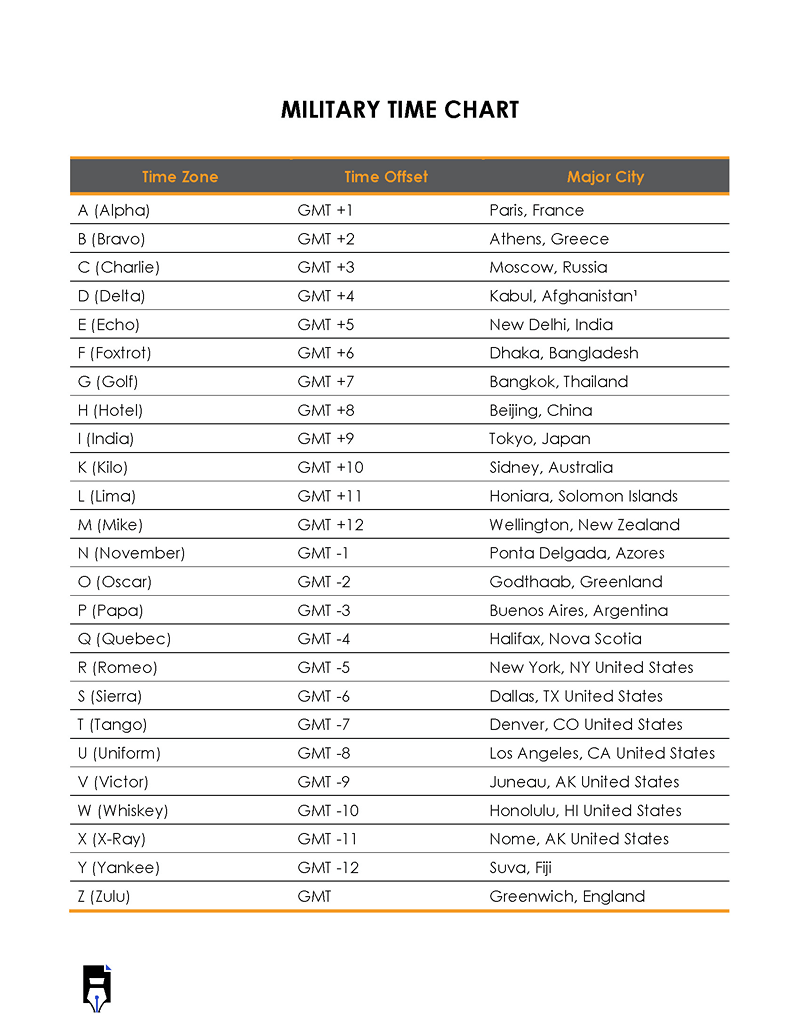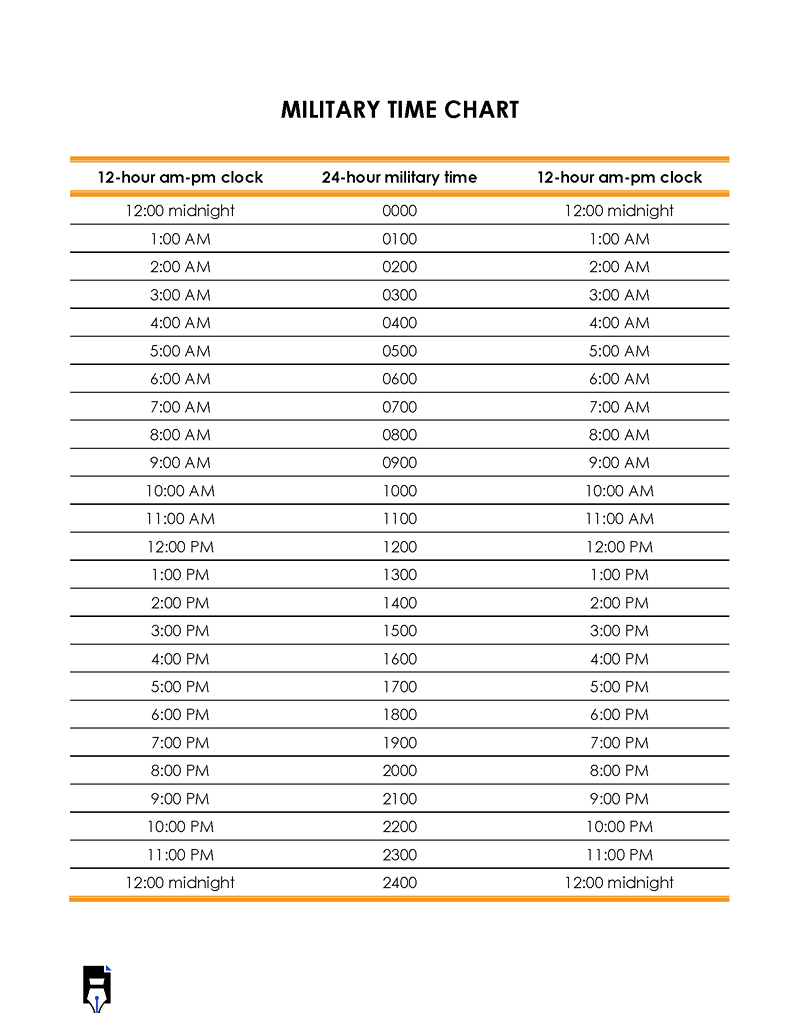Around 600 BC, ancient Egyptians used a method called constellation tracking to monitor hours, days, and seasons. Using this technique, they could determine how long a constellation would take to traverse the sky. This technique introduced not only 24-hour conversion but also the modern 365-day calendar.
24-hour military time Chart , also known as the 24-hour clock or the military time system, is a timekeeping system used by the military, emergency services, and in some other contexts where 24-hour notation is preferred. In this system, the day is divided into 24 hours, starting from midnight (00:00) and ending at 23:59. Each hour is represented by a two-digit number, ranging from 00 to 23.
The British Royal Navy started using the 24-hour clock during World War I in 1914. This switch encouraged other Allied forces to follow suit. The United States Army, however, did not adopt the clock until 1942.
To help you convert time from 12 hours to 24 hours, you can use a printable 24-hour time chart. It provides a simple and accurate conversion of hours and minutes. This article will help you understand the 24-hour clock and how to use the chart. Methods for conversion and reasons for using the chart have also been outlined. Free downloadable templates for this chart have also been provided for your convenience.
Military Time Chart Templates
You can download the following templates for free:
Understanding Military Time: How to Use a 24-Hour Clock
Without some insight into the distinctions between a 12 and 24-hour clock, the significance of a military time chart makes little sense. With a 12-hour clock, “morning” and “afternoon” times are abbreviated by the initials a.m. and p.m., respectively. A.m. stands for ante meridiem, or before noon, and p.m. for post meridiem, or after noon. As a result, times between midnight and noon are denoted by a.m., while times between noon and midnight are denoted by p.m.
The 24-hour clock, on the other hand, is from 0 to 23, whereas the 12-hour clock cycles between 1 and 12 twice. In this system, 23 represents 11 p.m., while 0 represents midnight. All times are indicated with at least four digits, so 11 p.m. is denoted as 2300 instead of just 23, and midnight is presented as 0000 instead of just 0. The last minute of the day may be denoted as 2359, i.e., a minute before the next day’s midnight.
All the morning times begin with a 0 as a placeholder because all four spaces must always be filled. A leading zero is used when writing the hours between midnight and 9:00 a.m. The numbers start with a 1 or a 2 from that point onward, such as 1100 for 11 a.m. and 2200 for 10 p.m. Most non-English speaking nations use the 24-hour clock. The International Organization of Standardization has established an international standard for it, titled ISO 8601. It is easier to understand what time one refers to when using a 24-hour clock. This system improves accuracy when discussing time, whether in writing or verbally.
Did You Know: In the healthcare sector, using the 24-hour system reduces inconsistencies and errors in timekeeping. This is according to a study listed in the Journal of Nursing Education and Practice.
Military Time Chart and its Uses
A 24-hour time chart is a document that aids in converting time from the standard 12-hour clock format to a 24-hour one. The chart has two columns; the left column contains the time in 12-hour format with one-hour increments, while the right column converts it to military time. Generally, the conversion process can be confusing. In such situations, this printable chart will be helpful.
The chart takes the format as shown below:
| Civilian Time | Military Time |
| 12:00 a.m.(Midnight) | 00:00 or 0000 Hours |
| 1:00 a.m. | 01:00 or 0100 Hours |
| 2:00 a.m. | 02:00 or 0200 Hours |
| 3:00 a.m. | 03:00 or 0300 Hours |
| 4:00 a.m. | 04:00 or 0400 Hours |
| 5:00 a.m. | 05:00 or 0500 Hours |
| 6:00 a.m. | 06:00 or 0600 Hours |
| 7:00 a.m. | 07:00 or 0700 Hours |
| 8:00 a.m. | 08:00 or 0800 Hours |
| 9:00 a.m. | 09:00 or 0900 Hours |
| 10:00 a.m. | 10:00 or 1000 Hours |
| 11:00 a.m. | 11:00 or 1100 Hours |
| 12:00 p.m. (Midday) | 12:00 or 1200 Hours |
| 1:00 p.m. | 13:00 or 1300 Hours |
| 2:00 p.m. | 14:00 or 1400 Hours |
| 3:00 p.m. | 15:00 or 1500 Hours |
| 4:00 p.m. | 16:00 or 1600 Hours |
| 5:00 p.m. | 17:00 or 1700 Hours |
| 6:00 p.m. | 18:00 or 1800 Hours |
| 7:00 p.m. | 19:00 or 1900 Hours |
| 8:00 p.m. | 20:00 or 2000 Hours |
| 9:00 p.m. | 21:00 or 2100 Hours |
| 10:00 p.m. | 22:00 or 2200 Hours |
| 11:00 p.m. | 23:00 or 2300 Hours |
As you progress forward from midnight (0000), you will stop repeating previous numbers and switch to 1300 once you reach 1:00 p.m. As a result, 2:00 p.m. would be 1400, 3:00 p.m. would be 1500, and so forth until you reach 23:59. It should be noted that the 12-hour clock and military time have the same number of minutes per hour and use minutes in the exact same way. Therefore, 9:27 p.m. would be 2127 hours, or 21:27 in military time.
Which Sectors Use the 24-Hour Clock
In addition to its use in the military, the 24-hour clock is commonly used in the following civilian sectors:
Healthcare
Hospitals and other healthcare facilities frequently use military time to avoid confusion and guarantee that patients are given the correct medication at the right times. Medical staff can seamlessly coordinate their actions and ensure patients receive optimal treatment with a uniform timekeeping system.
Aviation
The aviation sector primarily uses the 24-hour clock system and the Coordinated Universal Time (UTC) for timekeeping and communication. This is to ensure standardized and consistent time references across different regions and time zones, promoting safety and efficiency in aviation operations.
Emergency services
Emergency responders such as fire departments, law enforcement agencies, and paramedics routinely use military time for public safety to prevent misunderstandings and ensure everyone aims for the same objectives. They can rapidly coordinate their efforts and respond to crisis situations more efficiently by adopting the 24-hour system.
Military Time Conversion Trick
Converting time from the 12-hour clock to the 24-hour clock and vice versa is not that difficult, and anyone can perform the conversion successfully. The day is divided into 24 hours in military time. Every hour is represented by a unique combination of digits, with the first two denoting the hour and the last two denoting the minutes. Remove the colon and the p.m. or a.m. denotations first. From there, treat the hour as a unit of 10 instead of a unit of one. This implies that a single-digit number, generally between 1 and 9, should have a zero before it. Therefore, 1:00 a.m. should be written as 0100 hours, 2:00 a.m. as 0200 hours, and so forth, up until 9.00 a.m. as 0900 hours.
As the time before noon reaches double digits, conversion becomes considerably simpler because all that is required is to remove the colon and the a.m. or p.m. notations. This means 10:00 a.m. becomes 1000 hours and 12:00 p.m. becomes 1200 hours. Starting at noon, add 12 to any time between 1:00 p.m. and 11:00 p.m. to convert from the 12-hour clock to a 24-hour clock. For example, adding 12 to 2:00 p.m. yields 1400 hours. Continue with this until you get to 2300 hours for 11:00 p.m., after which the clock resets.
Converting the 24-hour clock to the 12-hour clock is simpler from 0100 to 1100 hours since all you have to do is add a colon, the a.m. denotation, and remove the leading zero. For times from 1300 hours onward, you merely need to subtract 12 and include the P.M. notation. For example, you would subtract 12 from 1300 to get 1:00 p.m., 1400 would become 2:00 p.m., and so on until you get to 11:00 p.m. when the clock resets.
When using it verbally, use ‘hundred’ instead of ‘thousand’ to convey the time correctly. For example, to say 0800, you would simply say ‘zero eight hundred’. When expressing military time in minutes, you must pronounce every number, for example, zero, five thirty for 0530, or sixteen fifty-five for 1655.
Related: Military Letter of Recommendation (30 Free Templates)
Why You Should Use a Printable Military Time Chart
While improving communication by adding another way to tell time may seem pointless, using a system that leaves no room for error might save lives. If you are unfamiliar with the 24-hour time format, you can use a military time chart for rapid reference and simple conversion.
Using this chart has the following advantages:
Eliminating confusion
In stressful situations where effective communication is key, military time helps prevent misunderstanding and confusion. Personnel can effectively oversee operations and ensure everyone is on the same page by adopting a standard time-tracking system. It also eliminates ambiguity in cases where the denotations a.m. and p.m. could be vague, such as when communicating across different time zones.
Efficiency and time-saving
Instead of manually calculating or mentally converting time, a printable military time chart allows for swift and efficient time conversion. It eliminates the need for guesswork or potential mistakes, especially in time-sensitive situations.
International coordination
Military time is widely used internationally, especially in sectors that require coordination across various time zones. A printable time chart enables smooth communication and synchronization when working with individuals or organizations from different countries.
Training and learning
For individuals who are unfamiliar with military time or are learning to adapt to it, a printable chart serves as a useful educational tool. It facilitates the understanding and familiarization of the 24-hour clock system.
Convenience
Printable military time charts are easily accessible and can be conveniently printed or stored digitally. They can be kept in a wallet, displayed on a bulletin board, or saved on a device for quick reference wherever and whenever needed.
Key Takeaways
Time conversion can be complicated if you primarily use a 12-hour clock but occasionally need to switch to a 24-hour one. If you need to convert between the two systems, a 24-hour time chart can be useful. It is also helpful if you are new to the 24-hour format and are still trying to understand it because of the numerous details that distinguish the 12-hour clock from the 24-hour clock. Additionally, the conversion will become easier over time if you use the chart frequently. The chart allows you to easily convert the exact hours and minutes without any ambiguity.
The chart is frequently used for its accuracy and is useful in the sectors of aviation, healthcare, law enforcement, and emergency services. Feel free to download one of our free 24-hour military chart templates, print it, and post it on your workstation. You may also carry it in your wallet or handbag.
